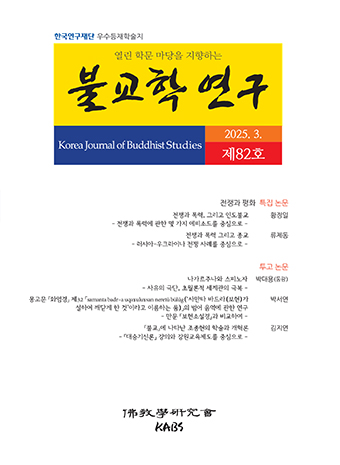- 영문명
- Nāgārjuna and Spinoza: The Extremes of thought, the Overcoming of the Transcendental World View
- 발행기관
- 불교학연구회
- 저자명
- 박대용(Dae-Yong PARK)
- 간행물 정보
- 『불교학연구』제82호, 53~76쪽, 전체 24쪽
- 주제분류
- 인문학 > 불교학
- 파일형태
- 발행일자
- 2025.03.31
5,680원
구매일시로부터 72시간 이내에 다운로드 가능합니다.
이 학술논문 정보는 (주)교보문고와 각 발행기관 사이에 저작물 이용 계약이 체결된 것으로, 교보문고를 통해 제공되고 있습니다.

국문 초록
이 논문을 쓰는 목적은 불교의 한 갈래인 중관철학에서 바라본 세계관과 우주관을 서구의 현상학적 이해를 통해 고찰하기 위함이다. 초기 불교와 아비달마 불교에서는 우리의 몸과 세계를 “5온 12처 18계”로 하는 구성주의적 세계관을 제시하였다. 반면 중관철학의 창시자인 나가르주나(Nāgārjuna)는 이러한 설일체유부의 ‘삼세실유와 법체항유의 다르마 존재론’이나 바이쉐시까학파의 6범주론과 같은 구성주의적 세계관을 해체하고 모두 거부하였다. 그는 “모든 것은 연기하므로 본질을 갖지 않으며 공이다”라고 하는 ‘공적(空的) 세계관’을 표명하였으며, 언어에서 가립된 희론(prapañca)의 속성을 지닌 세속적 존재(=세속유)와 희론이 적멸된 승의적 존재(=승의유)가 빚어내는 환원 불가능한 초월론적 이원론의 세계관(=이제설)을 새롭게 주창하였다. 이 이원론적 세계관은 일체의 본성을 무자성(niḥsvabhāva)’과 ‘공성(śūnyatā)’으로 규정하는 공적 세계관이어서 세속유를 방편의 가설적 존재(=가설유)로 모두 격하시키고 마침내 절대공의 세계로 나아가게 된다.
한편 중관철학은 그 형성 초기부터 “연기·무자성·공·중도”의 핵심 이념을 내세웠다. 그런데 무엇 때문에 이 중관철학은 허무주의(니힐니즘)라고 하는 합당치 못한 주홍글씨의 오명을 덮어 쓰게 되었을까? 중관철학의 귀류 논증은 서구의 귀류 논법과 유사한 방식인데, 즉 대론자의 주장을 끌어와 그 안에 내포된 오류와 모순을 드러내어 대론자의 주장 자체를 무화 해체해 버림으로써 자신들의 논지를 명석판명하게 하는 방식이다. 그렇지만 이와 달리 논자는 본고에서 스피노자의 신즉자연(神卽自然) 사상을 비롯한 서구의 현상학 이념을 끌어와 나가르주나의 중관철학 세계관과 우주관을 이해하기 위한 방편으로 삼았다. 이러한 검토를 통해, 논자는 스피노자가 신의 무한절대성을 이용해 능산(能産)과 소산(所産)의 자연의 이치로 지평을 확대하려고 한 것은 나가르주나의 절대 부정을 통한 절대 긍정과도 그 맥이 닿아 있음을 확인할 수 있었다.
영문 초록
This paper uses a phenomenological approach to examine the world and universe from the perspective of Mādhyamaka, a branch of Buddhist philosophy. Early Buddhism and Abhidharma Buddhism proposed a constructivist worldview that describes the human body and the external world as the “five skandhas, twelve āyatanas, and eighteen dhātus.” However, Nāgārjuna, the founder of Mādhyamaka—celebrated for his eight types of investigations—rejected and deconstructed all constructivist worldviews, including the “Dharma ontology of the Three Seil and the Legal Portability” of Confucianism and the six categories of the Vaiśeṣika school. He described a “world of acting,” asserting that “nothing has an essence because it acts and is a sphere of action.” He introduced the [二諦說] worldview of irreversible transcendental dualism, wherein prapañca (conceptual proliferation) is separated from language and rationalism is extinguished. This dualistic view reduces the secular realm to a universal hypothetical existence—grounded in the principle that “niḥsvabhāva” (no intrinsic nature) and “śūnyatā” (emptiness) constitute “the nature of all things”—ultimately moving toward absolute emptiness.
Yet did Mādhyamaka philosophy initially uphold the ideology of “acting, selflessness, universality, and moderation”? And how did it come to be branded with the misplaced stigma of nihilism? The debate over Mādhyamaka’s “regression” parallels similar arguments in Western philosophy, where one exposes an opponent’s position and dismantles it by revealing its errors and contradictions. In this context, the argument invokes Spinoza’s notion of 神卽自然 (the divinity of nature) as a way to interpret Nāgārjuna’s Mādhyamaka worldview. In other words, it suggests that Spinoza’s effort to expand the horizon of 能産 (productive capacity) and 所産 (produced phenomena) through God’s infinite absoluteness aligns with Nāgārjuna’s method of absolute affirmation achieved through absolute negation.
목차
Ⅰ. 들어가는 말
Ⅱ. 중관철학의 해체주의적 세계관
Ⅲ. 현상학적 환원으로도 분할할 수 없는 무이중도의 세계
Ⅳ. 서양철학에서 바라본 구성주의적 세계관과 환원주의적 세계관
Ⅴ. 나오는 말
키워드
해당간행물 수록 논문
참고문헌
관련논문
인문학 > 불교학분야 BEST
더보기인문학 > 불교학분야 NEW
- 역사적 붓다의 본성에 대한 재고찰 - 초기 불교 문헌을 완성된 전체로 파악하는 접근법에 입각하여
- 『능가경』은 여래장과 알라야식을 동일시했는가?
- 선사상에 나타난 초목불성의 전개와 함의
최근 이용한 논문
교보eBook 첫 방문을 환영 합니다!

신규가입 혜택 지급이 완료 되었습니다.
바로 사용 가능한 교보e캐시 1,000원 (유효기간 7일)
지금 바로 교보eBook의 다양한 콘텐츠를 이용해 보세요!



